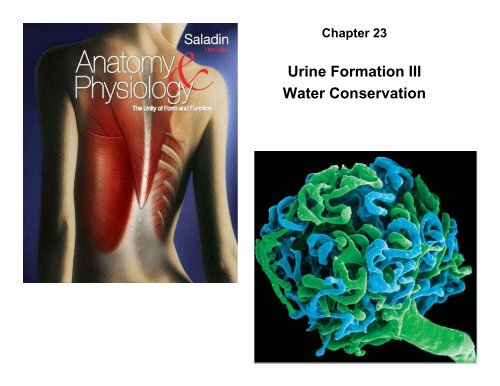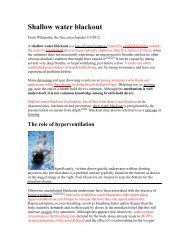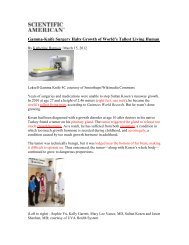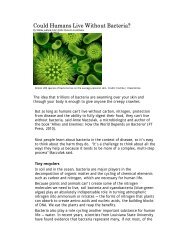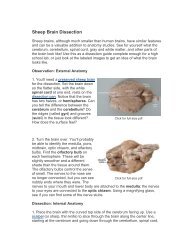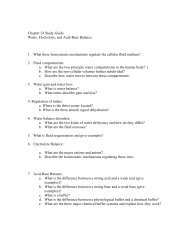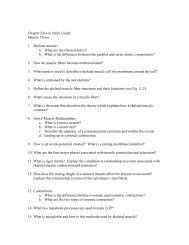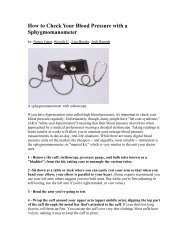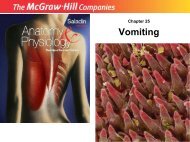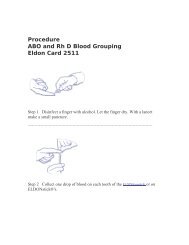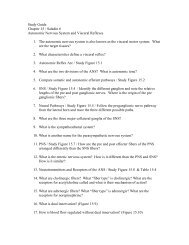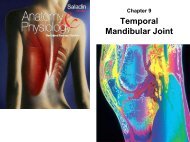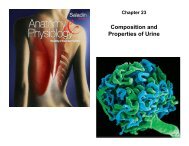Urine Formation III Water Conservation
Urine Formation III Water Conservation
Urine Formation III Water Conservation
- No tags were found...
You also want an ePaper? Increase the reach of your titles
YUMPU automatically turns print PDFs into web optimized ePapers that Google loves.
Chapter 23<br />
<strong>Urine</strong> <strong>Formation</strong> <strong>III</strong><br />
<strong>Water</strong> <strong>Conservation</strong>
<strong>Urine</strong> <strong>Formation</strong> <strong>III</strong>:<br />
<strong>Water</strong> <strong>Conservation</strong><br />
• the kidney eliminates metabolic wastes from<br />
the body, but also prevents excessive water<br />
loss as well<br />
• as the kidney returns water from the tubules<br />
back into the tissue fluid and bloodstream<br />
• the fluid remaining in the renal tubules<br />
passes as urine<br />
– this fluid becomes more concentrated!
Collecting Duct Concentrates <strong>Urine</strong><br />
Tubular fluid<br />
(300 mOsm/L)<br />
• collecting duct (CD)<br />
begins in the cortex<br />
where it receives tubular<br />
fluid from several<br />
nephrons<br />
Osmolarity of tissue fluid (mOsm/L)<br />
300<br />
600<br />
900<br />
1,200<br />
H 2 O<br />
H 2 O<br />
H 2 O<br />
H 2 O<br />
H 2 O<br />
Cortex<br />
Medulla<br />
Collecting<br />
duct<br />
Nephron<br />
loop<br />
• as CD passes through<br />
the medulla, it reabsorbs<br />
water and concentrates<br />
urine up to four times<br />
• medullary portion of CD<br />
is more permeable to<br />
water than to NaCl<br />
• as urine passes through<br />
the increasingly salty<br />
medulla, water leaves by<br />
osmosis concentrating<br />
urine<br />
<strong>Urine</strong><br />
(up to 1,200 mOsm/L)
Control of <strong>Water</strong> Loss<br />
• How concentrated the urine becomes depends on body’s<br />
state of hydration:<br />
– water diuresis – drinking large volumes of water will<br />
produce a large volume of hypotonic urine<br />
• cortical portion of CD reabsorbs NaCl, but it is<br />
impermeable to water<br />
• salt removed from the urine stays in the CD<br />
• urine concentration may be as low as 50 mOsm/L<br />
– producing hypertonic urine<br />
• dehydration causes the urine to become scanty and more<br />
concentrated<br />
• high blood osmolarity stimulates posterior pituitary to<br />
release ADH and then an increase in synthesis of<br />
aquaporin channels by renal tubule cells<br />
• more water is reabsorbed by collecting duct<br />
• urine is more concentrated<br />
– If BP is low in a dehydrated person, GFR will be low.<br />
• filtrate moves more slowly and more time for reabsorption<br />
• more salt removed, more water reabsorbed and less urine<br />
produced
Countercurrent Multiplier<br />
• the ability of kidney to concentrate urine depends on<br />
salinity gradient in renal medulla<br />
– four times as salty in the renal medulla than the cortex<br />
• nephron loop acts as countercurrent multiplier<br />
– multiplier - continually recaptures salt and returns it to extracellular<br />
fluid of medulla which multiplies the salinity in adrenal medulla<br />
– countercurrent - because of fluid flowing in opposite directions in<br />
adjacent tubules of nephron loop<br />
• fluid flowing downward in descending limb<br />
– passes through environment of increasing osmolarity<br />
– most of descending limb very permeable to water but not to NaCl<br />
– water passes from tubule into the ECF leaving salt behind<br />
– concentrates tubular fluid to 1,200 mOsm/L at lower end of loop<br />
• fluid flowing upward in ascending limb<br />
– impermeable to water<br />
– reabsorbs Na + , K + , and Cl - by active transport pumps into ECF<br />
– maintains high osmolarity of renal medulla<br />
– tubular fluid becomes hypotonic – 100 mOsm/L at top of loop<br />
• recycling of urea: lower end of CD permeable to urea<br />
– urea contributes to the osmolarity of deep medullary tissue<br />
– continually cycled from collecting duct to the nephron loop and back<br />
– urea remains concentrated in the collecting duct and some of it<br />
always diffuses out into the medulla adding to osmolarity
Countercurrent Multiplier of Nephron Loop<br />
1<br />
More salt is continually<br />
added by the PCT.<br />
300<br />
100<br />
5<br />
The more salt that<br />
is pumped out of the<br />
ascending limb, the<br />
saltier the ECF is in<br />
the renal medulla.<br />
2<br />
The higher the osmolarity<br />
of the ECF, the more water<br />
leaves the descending limb<br />
by osmosis.<br />
400<br />
Na +<br />
K +<br />
Cl –<br />
200<br />
Na +<br />
K +<br />
Cl –<br />
H 2<br />
O<br />
H 2<br />
O<br />
600<br />
Na +<br />
K +<br />
Cl –<br />
400<br />
Na +<br />
K +<br />
Cl –<br />
H 2<br />
O<br />
3<br />
The more water that leaves<br />
the descending limb, the<br />
saltier the fluid is that<br />
remains in the tubule.<br />
H 2<br />
O<br />
900<br />
Na +<br />
K +<br />
Cl –<br />
H 2<br />
O<br />
700<br />
4<br />
Na +<br />
K +<br />
Cl –<br />
The saltier the fluid in the<br />
ascending limb, the more<br />
salt the tubule pumps into<br />
the ECF.<br />
1,200
Countercurrent Exchange System<br />
• vasa recta – capillary branching off efferent arteriole in<br />
medulla<br />
– provides blood supply to medulla and does not remove NaCl and<br />
urea from medullary ECF<br />
• countercurrent system - formed by blood flowing in<br />
opposite directions in adjacent parallel capillaries<br />
• descending capillaries<br />
– exchanges water for salt<br />
– water diffuses out of capillaries and salt diffuses in<br />
• as blood flows back up to the cortex the opposite occurs<br />
• ascending capillaries<br />
– exchanges salt for water<br />
– water diffuses into and NaCl diffuses out of blood<br />
– the vasa recta gives the salt back and does not subtract from the<br />
osmolarity of the medulla<br />
• absorb more water on way out than the way in, and thus they<br />
carry away water reabsorbed from the urine by collecting duct<br />
and nephron loop
Maintenance of Osmolarity in Renal Medulla<br />
Countercurrent Multiplier<br />
Loop of Henle<br />
Countercurrent Exchange<br />
Vasa Recta<br />
Osmolarity of<br />
ECF<br />
(mOsm/L)<br />
300<br />
300<br />
300<br />
100<br />
100<br />
300 300<br />
300<br />
400<br />
600<br />
900<br />
Cortex<br />
Medulla<br />
Key<br />
Active transport<br />
Urea<br />
H 2 O<br />
Urea<br />
400<br />
600<br />
900<br />
Na +<br />
K +<br />
Cl –<br />
Urea<br />
200<br />
200<br />
700<br />
Na +<br />
K +<br />
Cl –<br />
Na +<br />
K +<br />
Cl – 400 Na +<br />
K +<br />
H Cl –<br />
2 O<br />
Urea<br />
Na +<br />
K +<br />
Cl – 400<br />
Urea<br />
500<br />
700<br />
Urea<br />
Urea<br />
H 2 O<br />
NaCl<br />
H 2 O<br />
NaCl<br />
400<br />
600<br />
900<br />
400<br />
600<br />
900<br />
H 2 O<br />
NaCl<br />
H 2 O<br />
NaCl<br />
1,200<br />
Diffusion through<br />
a membrane channel<br />
H 2 O<br />
1,200<br />
1,200<br />
1,200<br />
Nephron loop<br />
Collecting duct<br />
Vasa recta
Summary of Tubular<br />
Reabsorption and Secretion<br />
Copyright © The McGraw-Hill Companies, Inc. Permission required for reproduction or display.<br />
Glucose Na +<br />
Amino acids K +<br />
Protein Ca 2+<br />
Vitamins Mg 2+<br />
Lactate Cl –<br />
Urea HCO – 3<br />
Uric acid<br />
H 2 O<br />
PCT<br />
Na +<br />
Cl –<br />
HCO – 3<br />
H 2 O<br />
DCT<br />
Urea H +<br />
Uric acid NH + 4<br />
Creatinine Some drugs<br />
Nephron loop:<br />
Descending limb<br />
Ascending limb<br />
Na +<br />
K +<br />
Cl –<br />
H +<br />
K +<br />
NH 4<br />
+<br />
Collecting<br />
duct<br />
Key<br />
H 2 O<br />
Urea<br />
H 2 O<br />
Urea<br />
See C23-6 for<br />
more details<br />
Tubular<br />
reabsorption<br />
Tubular<br />
secretion


